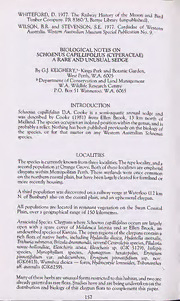
Biological Notes on Schoenus Capillifolius (Cyperaceae) a Rare and Unusual Sedge PDF
Preview Biological Notes on Schoenus Capillifolius (Cyperaceae) a Rare and Unusual Sedge
WHITEFORD, D. 1977. The Railway History of the Mason and Bird Timber Company. PR 8360/3, Battye Library (unpublished). WILSON, B.R. and STEVENSON, S.E. 1977. Cardiidae of Western Australia. Western Australian Museum Special Publication No. 9. BIOLOGICAL NOTES ON SCHOENUS CAPILLIFOLIUS (CYPERACEAE) A RARE AND UNUSUAL SEDGE By G.J. KEIGHERY,1- Kings Park and Botanic Garden, West Perth, W.A. 6005 2-Department of Conservation and Lind Management W.A. Wildlife Research Centre P.O. Box 51 Wanneroo, W.A. 6065 INTRODUCTION Schoenus capillifolius D.A. Cooke is a sembaquatic annual sedge and was described by Cooke (1981) from Ellen Brook, 13 km north of Midland. The species occupies an isolated position within the genus, and is probably a relict. Nothing has been published previously on the biology of the species, or for that matter on any Western Australian Schoenus species. LOCALITIES The species is currently known from three localities. The type locality, and a second population at Orange Grove. Both of these localities are empheral claypans within Metropolitan Perth. These wetlands were once common on the northern coastal plain, but have been largely cleared for farmland or more recently housing. A third population was discovered on a railway verge at Waterloo (12 km N. of Bunbury) also on the coastal plain, and an ephemeral claypan. All populations are located in remnant vegetation on the Swan Coastal Plain, over a geographical range of 150 kilometres. Associated Species. Claypans where Schoenus capillifolius occurs are largely open with a spare cover of Melaleuca laterita and at Ellen Brook, an undescribed species of Kunzea. The open regions of the claypans contain a rich flora of native herbs, including Hydatella dioica, Hydatella australis, Trithuria submersa, Brizula drummondii, several Centrolepis species, Pilularia novae-hollandiae, Eleocharis acuta, Eleocharis sp. (GK 5179), Isolepis species, Myriophyllum species, Aponogeton hexatepalus, Eryngium pinnatifidium' var. subdecumbens, Eryngium pinnatifidium ssp. nov. (GK6413), Wumtbea dioica — form, Hydrocotyle lemnoides, Tribonanthes aff. australis (GK6259). Many of these herbs are unusual forms restricted to this habitat, and two are already gazetted as rare flora. Studies have and are being undertaken on the distribution and biology of this claypan flora to complement this paper. 157 BIOLOGY The claypan at Orange Grove was visited each week from May to October, 1983 to undertake observations on this, and other native herbs. Monthly visits were undertaken during January to April, 1983, and November to December, 1983. Transplants were grown (in semi-submerged pots in an aquarium) at Kings Park in a temperature controlled growth chamber for detailed observations on flower behaviour and breeding system studies. Fruits germinate when winter rains flood the claypans in May and June. Growth occurs while submerged, till the water level begins to fall in Spring when flowering occurs, generally while the plants are still submerged. Some open flowers and some cleistogamous flowers are produced underwater in September. The cleistogamous flowers produce normal fruit. Flowering peaks as the water level is receding rapidly in October and finishes in November as the swamps dry. c: habit d: fruit in dried floret e: fruit (scale bar = 1mm) voucher a-c, G. Keighery 2456: KPBG, MEL d-e, G. Keighery 4035: PERTH 158 During flowering “floral tubes” formed by the glumes around the inflorescence (Fig 1, a) are produced through the water and mud in which the plant is rooted as the leaves unsupported by water lie on the mud (Fm 1 c). This ensures the stigma and stamens are held above the water in the air (pollination is by wind). Plants occur in dense populations in these claypans. The individual inflorescence is protandrous, normally the pollen beine shed before the stigma emerges (Fig 1, B). However, when manual self pollinadon was performed on cultivated plants from Orange Grove and Midland well filled nuts were produced, suggesting the plants are self fertile. Seeds develop with the floral tube (Fig 1, d and e) and remain in situ in the dead adult plants foilage during summer. The first heavy rains and storms of winter break up the adult plants allowing germination to occur in the same site that the adult occupied. The floral morphology of this species o fShoenus is unique in the genus and relates closely to its aquatic lifestyle. Unlike all other species’ the inflorescence acts as a single flower and its placement in the genus Schocnus may be questioned. CONSERVATION Two of the three known populations of this unusual annual are currently within existing or proposed conservation reserves. However both of these are small and the species would be exceedingly vunerable to disturbance of the hydrological cycle of these ponds (by drainage) or weed invasion (changing the fire regime, direct competition or changing the wind flow patterns around the claypan). REFERENCE COOKE, D.A. 1981. “New species of Schoenus (Cyperaceae) and Trithurin (Hydatellaceae)”. Muelleria 4: 299-303. FIRST RECORDS OF THE MULGARA, DASYCERCUS CRISTICAUDA, FROM THE GIBSON DESERT AND QUEEN VICTORIA SPRING NATURE RESERVES By DAVID PEARSON, Department of Conservation and Land Management, P.O. Box 51, Wanneroo, W.A. 6065 The Mulgara, Dasycerus cristicauda, has a wide distribution in the arid regions of the Northern Territory, South Australia, Western Australia and the south-western corner of Queensland (Woolley 1983). Throughout most of its range it is considered rare, except in the Tanami Desert (N.T.) where Gibson (1986) reported it was “generally widespread and common”.
